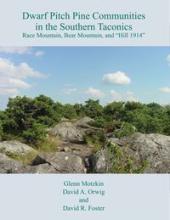You are here
Harvard Forest Studies Rare Pitch Pine Communities

Harvard Forest scientists Glenn Motzkin, David Orwig, and David Foster recently used a combination of dendroecological, historical, and field studies to examine the long-term history, development, and vegetation dynamics of 3 dwarf P. rigida (pitch pine) locations in the southern Taconic mountains of southwest Massachusetts and northwestern Connecticut. All three sites supported communities dominated (80 to 98% relative importance) by stunted P. rigida, which apparently persisted in the absence of frequent fire because of the harsh site conditions, especially shallow soils and frequent damage from winter storms. Cone serotiny, which is characteristic of dwarf P. rigida communities elsewhere in the eastern U.S., was not observed on any of the summits, consistent with the lack of frequent fire. Of the three areas studied, Race Mountain had the highest density of dwarf P. rigida (1482 stems ha-1 ), approximately three times the density on Bear Mountain. Hill 1914 had the highest P. rigida basal area (18 m2 ha-1 ), ~ four times the basal area on Bear Mountain. Interestingly, Bear Mountain had substantially lower densities of dead P. rigida than the other summits, and supported higher P. rigida seedling and sapling densities and contained more upright stems with well-defined leaders. Understory vegetation among the three sites was quite similar. Average age of P. rigida was greater on Hill 1914 (111 years) than on Race Mountain (93 years). Although none of the sites was characterized by old-growth P. rigida, Hill 1914 supported the oldest known P. rigida in Massachusetts (228 years old).
Motzkin, G., D.A. Orwig and D.R. Foster 2009. Dwarf Pitch Pine Communities in the Southern Taconics: Race Mountain, Bear Mountain and "Hill 1914". Harvard Forest Paper 29. 42 pages.

